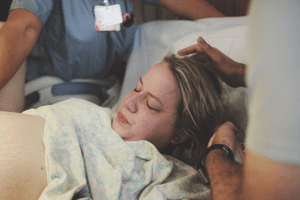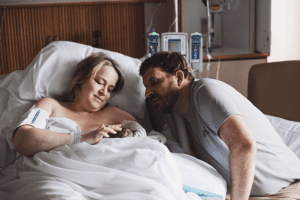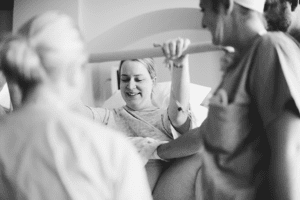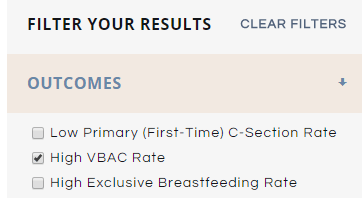[2023] Road Map to a VBAC in the Chicago Area
[Updated 11/9/2023]
You had a c-section with your previous pregnancy and now you’re pregnant again. Will you try for a vaginal birth after cesarean (VBAC) this time around, or will you plan a repeat c-section? This article points you to some third-party resources that will help you consider which way to go, and then walks you through the process of finding the best VBAC providers.
We cover:
- VBAC or repeat Cesarean — resources to help you decide
- Choosing a VBAC-friendly hospital and practitioner
- Best Chicago-area hospitals for VBAC
- Options for midwife-attended VBAC
- Options if you’ve had two prior C-sections (VBA+2C)
- VBAC in a midwife-led birth center
[Note that several Chicago-area home birth providers may offer the option of a home birth after cesarean, but only if your most recent birth was a successful VBAC. This article focuses on options for women who have not had a vaginal birth since their last cesarean, so we don’t address the option of VBAC at home.]
The old adage “once a cesarean, always a cesarean” has been debunked.
The American College of Obstetricians and Gynecologists (ACOG) current practice bulletin relating to VBAC takes the position that women with one or two previous c-sections are candidates for a trial of labor after cesarean (TOLAC) and should be counseled about and offered a TOLAC. (See “Summary of Recommendations and Conclusions” section in full text of Practice Bulletin.) ACOG also recognizes that “the ultimate decision to undergo TOLAC or a repeat cesarean delivery should be made by the patient in consultation with her obstetrician or obstetric care provider. The potential risks and benefits of both TOLAC and elective repeat cesarean delivery should be discussed.”
The American College of Nurse Midwives (ACNM) similarly encourages a trial of labor after c-section (TOLAC): “Women who are candidates for labor after cesarean should be encouraged to consider VBAC.
So VBAC is an option every woman should at least look into.
Here are some resources to help you weigh trial of labor vs. planned cesarean:
- ACOG FAQs: Vaginal Birth After Cesarean Delivery – Deciding on a Trial of Labor After Cesarean Delivery – FAQs from the American College of Obstetricians and Gynecologists
- Childbirth Connection – offers a helpful overview of VBAC, including “VBAC Basics”, “Planning Ahead”, “Research and Evidence”, and “VBAC Resources”
- International Cesarean Awareness Network (ICAN) – a leading national organization dedicated to preventing unnecessary cesareans, supporting cesarean recovery and promoting vaginal birth after cesarean (VBAC)
- Lamaze International infographic – a one-page summary of facts about VBAC
- VBAC.com – a source for evidence-based information, resources, continuing education and support for VBAC
- VBAC Facts – offers a comprehensive paid online course for women and their partners that will walk you through the research and other considerations to help you decide whether you’re interested in VBAC
- Choosing the route of delivery after cesarean birth – UpToDate – If you’re willing to wade through difficult medical language, this excellent overview of the research evidence (written for medical providers) is a great resource.
Choosing a provider for trial of labor after cesarean (“TOLAC”)
If you decide to try for a vaginal birth this time around, your first priority should be to find a supportive provider. You’re not just looking for someone who says “yes”, you’re looking for someone who enthusiastically supports a trial of labor after c-section.
This is the key piece of advice offered by Erica Fleischer, who at the time of this interview was leader of the Chicago Chapter of the International Cesarean Awareness Network, Inc. (ICAN) — a nonprofit organization whose mission is “to improve maternal-child health by reducing preventable cesareans through education, supporting cesarean recovery, and advocating for vaginal birth after cesarean (VBAC).”
As Fleischer explains, “You’ll hear from a lot of providers that, ‘Sure, you can have a VBAC.’ But then if you don’t go into labor spontaneously before 39 or 40 weeks, they want to do a repeat c-section. Or if you develop a medical condition that means you need to deliver right away, they refuse to induce you, so they’re basically requiring you to have a c-section. We always tell people that the most important thing is to have a provider is truly supportive.” That means providers who actively promote VBAC.
Dr. Richard K. Silver is the Chairman of Obstetrics and Gynecology and Chief Academic Officer at NorthShore University HealthSystem. He practices at NorthShore’s Evanston Hospital, which is where Erica Fleischer had her VBAC and which has one of the very best VBAC rates in the Chicago area. Dr. Silver attributes the hospital’s excellent outcomes in part to the fact that it’s a Level III hospital, which means that the doctors and midwives there see some of the rare but serious complications that can arise when a woman has multiple cesareans.
As Dr. Silver explains it, “Repeat cesarean is more risky for the mother. For instance, we inherit patients from other hospital systems when their placenta grows through the uterine wall and threatens their life. We handle up to 20 cases a year. These are really challenging cases, involving transfusions, multiple surgeries, urological issues. This is one of the risks of repeat cesareans and one of the long term consequences of not offering vaginal trial of labor appropriately.”

Saint Anthony Hospital is another top performing hospital for VBAC in the Chicago area. Saint Anthony has a unique model: all pregnant and laboring women are cared for in the first instance by Saint Anthony’s midwives, backed up by a team of obstetricians. That means that the culture at Saint Anthony strongly reflects the midwifery model of care — a culture of patience, confidence in the natural process of birth, respect for the broad range of normal, and an emphasis on communication and shared decision-making.
According to Dr. Michele Bucciero, Saint Anthony Hospital’s Clinical Director in Obstetrics and Gynecology, that culture is key to the hospital’s excellent VBAC outcomes. “You have to explain to patients why you’re not necessarily intervening right away and why you’re letting them do things on their own. And I think you have to be patient. You can’t be anxious, running to the back for surgery if they don’t make progress every two hours. You have to give them the time.”
Michelle Korzek, CNM, is the Directory of Midwifery Services at Saint Anthony Hospital. She attributes the hospital’s culture of patience in part to the unique perspective that midwives bring. “As midwives, we’re not going to look at someone who’s had a previous c-section as being ‘abnormal’ per se. We always look at birth as a normal life process. That gives us confidence to leave the process alone more of the time.”
It’s clear that the midwives and OBs at Saint Anthony are totally aligned on this. As Dr. Brucciero says, “It’s how midwives train and how they look at birth, which is so drastically different than how obstetricians train and look at birth. If I were interested in a trial of labor after cesarean, I would definitely want a midwife taking care of me.”
The question of training is clearly important. Dr. Silver has been in practice for more than 30 years and he has seen drastic changes in approaches to VBAC over that time. “When I was in training, we offered pretty much everybody a trial of labor and the success rate was around 80%. For women with non-recurring indications [meaning that the reason for their previous c-section is not likely to recur this time around], 8 or 9 out of ten would delivery vaginally. And even those with the lowest odds of success, maybe someone who got stuck at seven centimeters or who pushed for four hours and still couldn’t deliver her baby, even those women have a 50/50 shot at delivering vaginally.”
Dr. Silver believes that providers can have skewed perceptions of the risks and benefits of a trial of labor. “Sometimes providers forget that if they allow trial of labor often enough, they’re going to be avoiding a lot of surgeries.”
Of course, it’s not providers but mothers who actually undertake the trial of labor. That raises another important component of good counseling, according to Dr. Bucciero. “Women need to go into it with realistic expectations. For most, it’s not going be a rapid birth. Most likely it’s going to take a while, you’re going to be uncomfortable. It might be a little anxiety provoking, and at the end of the day you may need another section. I think that’s just something people have to understand. So you need to be patient and realistic. And what that requires is confidence. It’s the provider’s job to give you that confidence.”
Dr. Silver agrees that confidence is critical. “When choosing a provider, I would ask, ‘what is the culture of your labor and delivery unit? Are your nurses and other folks supportive of this or do they get anxious when they have a patient with a scarred uterus?’” The anxiety of people around you can undermine your confidence and derail your labor.
Because it’s so important to find a supportive provider, don’t limit yourself to nearby hospitals. An hour or even an hour and a half drive might be inconvenient for prenatal visits and unpleasant when you’re in labor, but ultimately could be worth it.
As Dr. Silver points out, “People get anxious about being far from the hospital, but I think that’s a little overrated, especially with a VBAC. A lot of moms had a protracted first labor so they’re not likely to have a rapid labor this time around.” Dr. Silver has cared for vaginal trial of labor patients who live as much as an hour and a half away. That means you can look beyond the hospitals closest to you to find providers you really trust. In the list of top options for VBAC below, you’re likely to find a hospital well within a safe distance almost no matter where you live in the Chicago area.
Other factors to consider when choosing your provider
The most important thing is to find a provider who is supportive. But there are other considerations as well.
One is monitoring technology. Mothers trying for a vaginal birth after cesarean are required to have continuous electronic fetal monitoring, where a belt around their belly transmits fetal heart tones to a receiver. In some hospitals, the monitor significantly limits the mother’s ability to move around. But some hospitals offer the option of monitoring by telemetry, which transmits the fetal heart tones wirelessly. That allows the laboring woman to walk around instead of being tethered to the monitor. As Erica Fleischer puts it, “All Chicago area hospitals will require you to be monitored the whole time for a TOLAC [trial of labor after cesarean], but that doesn’t have to mean you’re stuck on your bed.” Being able to move around and try different positions can help you labor effectively, and an effective labor is less likely to end with a cesarean.
Another question to ask is whether there is an anesthesia team in the hospital at all times. This is important so that if a cesarean birth becomes necessary, it can be performed without delay.

Not every mother who qualifies for and chooses a trial of labor will have a vaginal birth, although success rates tend to be very high, often around 80 – 90% or more. But for many woman, the decision to try for a VBAC has benefits even if another cesarean becomes necessary. Dr. Bucciero puts it like this: “ I think at the end of the day, even if people aren’t successful, I feel like they’re okay getting another c-section, knowing they put in their best effort. There is some kind of mental shift and bonding that happens just by going through the labor process, that a lot of people that walk in and get a c-section don’t necessarily experience. I feel like people that go through labor and really give it their all often end up more satisfied with their choice, even if they don’t end up having a natural delivery.”
Summing it up

Instead, plan to get opinions from several doctors and/or midwives who support and have attended lots of successful VBACs. You’ll get a more balanced feel for the risks and benefits of a trial of labor by hearing multiple points of view, and you’re also more likely to find someone you truly connect with. A trusting relationship is especially important for a trial of labor after c-section since you need to feel confident that you and your provider have the same goals.
The best way to find VBAC-supportive providers is to start with hospitals and midwife-led birth centers that have high VBAC rates. (See our list below). Remember that not all hospitals and not all individual practitioners have the same criteria for trial of labor after cesarean. Just because you don’t qualify in one setting does not mean that you don’t qualify anywhere.
You can also find a list of BirthGuide members who can help you prepare for a VBAC here.
You don’t need to limit yourself to the hospitals closest to you. Many providers will agree to care for you even if you are traveling a distance to get to them. Given the importance of finding a supportive provider, cast a wide net if you need to.
When you’re interviewing providers at your setting of choice, here are some questions to ask:
- Will you allow me to go past my due date if that’s my informed decision?
- Are you willing to induce or augment my labor if that becomes medically necessary?
- Will I have fewer options in labor because I’ve had a previous c-section?
- What are the advantages and disadvantages of a trial of labor in my case?
- What are the advantages and disadvantages of planning a repeat cesarean in my case?
- How confident are you that I can successfully have a VBAC?
- Do you offer telemetric monitoring?
- Do you have anesthesia teams on-site 24/7?
Best options for trial of labor after cesarean in the Chicago area
If you’re planning a VBAC, here are answers to some of the questions you may have, including:
- What are the best hospitals for VBAC in the Chicago area?
- Where can I have a midwife-attended VBAC?
- Where can I have a VBAC in a birth center?
- Where can I have a VBAC after two cesareans (VBA2+C)?
- What hospitals have above-average VBAC rates?
⇒ TIP: You can use the BirthGuide search tools to find good VBAC providers. Go to the provider search page on BirthGuideChicago.com and use the “High VBAC Rate” filter in the left-hand column to find the hospitals with the highest VBAC rates:
Or use the drop down in the “Sort by” box to sort search results by VBAC rate, highest to lowest:
Best Hospitals for VBAC in Chicago
Based on most recent Illinois Department of Public Health statistics for VBAC rates and volumes (covering the period 10/1/2021 to 9/30/2022), the top eight hospitals for VBAC in the Chicago area are:
| Hospital | Risk-adjusted VBAC rate | # of uncomplicated VBACs | # of births to women/people with a prior C-section |
| Northshore Univ HS Evanston Hospital | 39.0 | 172 | 441 |
| Saint Anthony Hospital | 37.5 | 45 | 120 |
| Advocate Trinity Hospital | 36.7 | 29 | 79 |
| Northshore Univ HS Swedish Hospital | 35.5 | 87 | 245 |
| UChicago Medicine | 34.1 | 123 | 361 |
| UI Health | 30.6 | 86 | 281 |
| Advocate Illinois Masonic Medical Center | 29.8 | 54 | 181 |
| West Suburban Medical Center | 27.7 | 44 | 159 |
Here is some more detail on each, arranged by location.
North
- NorthShore University Evanston Hospital: More than 170 babies were born by VBAC at NorthShore University HealthSystem Evanston Hospital in the reporting year, and the hospital’s VBAC rate (39%) is the highest among Chicago-area hospitals. Both midwives and doctors support trial of labor after cesarean. With a VBAC rate that is the very highest for Chicago-area hospitals (and improved over the past reporting year’s already excellent performance), and with the highest volume of VBACs among hospitals in this category, Evanston Hospital is the top choice for VBAC in the Chicago area.
North Central
- Swedish Hospital | Part of NorthShore: Swedish Hospital made the list of top hospitals for VBAC in this reporting period. Eighty-seven mothers had successful, uncomplicated VBACs and the hospital’s VBAC rate of 35.5% has improved substantially over both the prior two reporting periods — an impressive improvement in this important quality measure. Both doctors and midwives support trial of labor after C-section.
Central
- University of Illinois Hospital & Health System: U of I continues to perform impressively in supporting TOLAC, with a successful, uncomplicated VBAC rate that’s held perfectly steady in the past two reporting periods at 30.6%.
- Advocate Illinois Masonic Medical Center:
South
- UChicago Medicine Family Birth Center: The doctors and midwives at the Family Birth Center at the University of Chicago attended over 125 successful VBACs in the most recent reporting year, with a VBAC rate that’s up more than 10% to 34.1% and with increasing volume.
- Advocate Trinity Hospital is new to this list of top performing hospitals for VBAC. It impressively increased its VBAC rate from 26.1% in the prior reporting period, to 36.7% most recently. Volumes are somewhat smaller than at the other hospitals in this list; however this hospital now boasts the third highest VBAC rate in the Chicago-area and has proven itself committed and skilled in supporting TOLAC.
West/Southwest
- Saint Anthony Hospital: While down slightly from the previous reporting period, Saint Anthony still ranks in the top two for VBAC success, as it has for the last 4 years in a row. Saint Anthony’s has a unique model of care: all women are in the care of midwives in the first instance, supported as needed by back-up obstetricians. This is equally true for women choosing a trial of labor after c-section. With its consistently excellent VBAC rates, Saint Anthony’s is one of the top two hospitals for VBAC in our area.
- West Suburban Medical Center in Oak Park continues to show improvement, and with the publication of the most recent IDPH data, has joined the ranks of hospitals with a VBAC rate that is more than one Standard Deviation higher than the average for the Chicago area. West Suburban also boasts a strong midwifery culture and has an Alternative Birthing Center that functions effectively as a midwife-led birth center within the hospital.
Options for midwife-attended VBAC
Seven of the eight top-rated hospitals offer midwife-attended VBAC:
- Saint Anthony Hospital (Chicago)
- Northshore Univ HS Evanston Hospital (Evanston)
- University of Chicago Medicine (Chicago)
- University of Illinois Hospital & Health System (Chicago)
- Swedish Hospital | Part of NorthShore (Chicago)
- Advocate Illinois Masonic Medical Center (Chicago)
- West Suburban Medical Center (Oak Park) and West Suburban Alternative Birthing Center (Oak Park) [in-hospital midwife-led birth center]
Other options for midwife-attended VBAC at hospitals with above-average VBAC rates are:
Options if you’ve had two prior c-sections (VBA2+C)
The American College of Obstetricians and Gynecologists takes the position that VBAC can be a safe and appropriate choice for some women who have had two prior cesarean births. Not all providers offer the option of VBAC to women who have had more than one c-section, but several do — including a number of the hospitals with the highest VBAC rates. If you’ve had two cesarean deliveries before this pregnancy, you may still have the option of a vaginal birth this time around, depending on the reasons for your past c-sections and other factors. The following hospitals are good places to start if this is something you’d like to pursue. Again, different providers will have different criteria for a trial of labor after two c-sections: just because one provider says no doesn’t necessarily mean they all will.
- Advocate Good Shepherd Hospital (Barrington)
- Advocate Lutheran General Hospital (Chicago)
- Humboldt Park Health (Chicago)
- NorthShore University HealthSystem Evanston Hospital (Evanston)
- Northwestern Medicine Prentice Women’s Hospital (Chicago)
- OSF Health Care Little Company of Mary Medical Center (Chicago)
- Saint Anthony Hospital (Chicago)
- Silver Cross Hospital (New Lenox)
- University of Chicago Medicine (Chicago)
- West Suburban Medical Center (Oak Park)
Option for VBAC in a midwife-led birth center
There are four midwife-led birth centers in the Chicago area: The Birth Center of Chicago, Burr Ridge Birth Center, The Birth Center at PCC [temporarily closed] and the Alternative Birthing Center (or “ABC”) at West Suburban Hospital. The first three are freestanding birth centers and Illinois regulations currently do not allow them to take VBAC patients. But the ABC at West Suburban Hospital is an in-hospital birth center and is equipped to handle VBACs. (Note that West Suburban also has a standard labor and delivery service where midwives also practice.) As a midwife-led birth center, the West Sub ABC follows the midwifery model of care, avoiding intervention whenever possible and offering hands-on support from providers who are experts in natural childbirth. Telemetry monitoring is available and the midwives are skilled at using positioning to help your labor along.
About the VBAC rates reported on BirthGuide
Providers are listed on BirthGuide as having a risk-adjusted VBAC rate that is “among the highest” if their VBAC rate is one standard deviation or more above the average rate for all hospitals listed on BirthGuide. (BirthGuide lists all maternity hospitals in Cook, Dupage and Lake counties that were included in the Illinois Department of Public Health’s “Illinois Health Report Card” as of 2/14/2019.) On the mobile version of the site, these providers’ VBAC rates are listed as “high”.
The VBAC rates used in this calculation come from the Illinois Department of Public Health (IDPH), which reports the VBAC rates for all Illinois hospitals. The IDPH VBAC rates reflect the number of women who have had at least one prior c-section in the past and who then have a vaginal birth at that hospital in the reporting year, divided by the number of all women who gave birth at that hospital in that year who have had at least one prior c-section. So the VBAC rate takes into account both the women who try for a VBAC and the women with a history of c-section who schedule a repeat cesarean with this pregnancy. The VBAC rates reported by IDPH are risk-adjusted.
Some providers also self-report their VBAC success rate. The VBAC success rate is the percentage of all women who choose a trial of labor who ultimately have a vaginal birth. That rate will be much higher than the overall VBAC rate because it considers only the population of women who qualify for and elect to try for VBAC, without taking into account women who are scheduled for a repeat c-section.
The highest overall VBAC rates will reflect both that a high percentage of women are offered a trial of labor and that skilled support helps a high percentage of those to succeed.
The photos in this article document a successful VBAC and are used with the permission of Amanda E Photography in Peoria Illinois.





